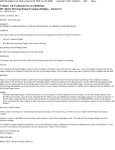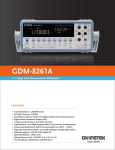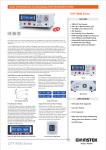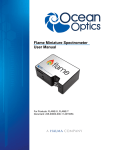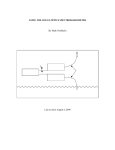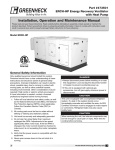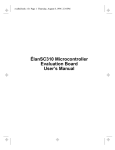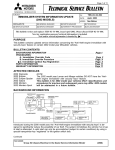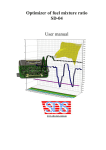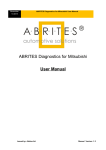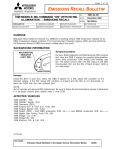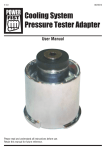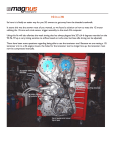Download Mitsubishi ORVR Systems
Transcript
17.25 Theory Module On-Board Refueling Vapor Recovery How will this module help you? The On-Board Refueling Vapor Recovery (ORVR) system will soon be adopted on all vehicles sold by MMSA. By completing this module, you will be better prepared to diagnose and repair possible malfunctions. SAFETY IS YOUR RESPONSIBILITY This technical training module is for use by professional Mitsubishi Motors dealership service technicians. The descriptions and procedures in this publication supplement existing service manuals, technical service bulletins, and other documents provided by Mitsubishi Motor Sales of America, Inc. (MMSA). As a result, the use of these sources may be required to ensure a proper repair. Within this module you will find Notes, Cautions, and Warnings. These references provide guidance to help you do your job efficiently and safely. The definitions for these terms are listed below. NOTE The purpose of a Note is to help you do your job more efficiently. A Note may also provide additional information to help clarify a particular point or procedure. CAUTION A Caution alerts you to the possibility of damage to either tools, equipment, or to the vehicle itself. A Caution recommends that a procedure must be done in a certain way to avoid potential problems resulting from improper technique or method. WARNING A Warning alerts you to the highest level of risk. Warnings inform you that a procedure must be done in a particular way to minimize the chances of an accident that could result in personal injury or even loss of life. When you see a Note, Caution, or Warning, be sure you understand the message before you attempt to perform any part of a service procedure. Also keep in mind it is impossible for MMSA to anticipate or evaluate every service situation a technician may encounter. For that reason, you have the final responsibility for personal safety–yours and those working around you. Be sure to always wear proper protective clothing and safety equipment, use the proper tools, and follow the repair procedures as outlined in various service publications provided by MMSA. No part of this publication may be reproduced, stored electronically, or transmitted in any form or by any means without prior written approval from Mitsubishi Motor Sales of America, Inc. MMSA reserves the right to make changes in the descriptions, specifications, or procedures without prior notice or obligation. Copyright © 1998 Mitsubishi Motor Sales of America, Inc. Corporate Technical Training Department On-Board Refueling Vapor Recovery MODULE GOAL OBJECTIVES Upon completion of this module, you will be able to identify the unique design characteristics that affect performance, diagnosis, and maintenance of the Onboard Refueling Vapor Recovery (ORVR) system. After completing this module, you will be able to: · Identify the benefits of an ORVR system over a conventional Strict Evaporative Emissions system. · Describe the ORVR system operation: - during refueling - while the vehicle is parked - while the vehicle is being driven · Identify the location and purpose of each of the ORVR components. WHAT YOU WILL NEED DIRECTIONS TIME TO COMPLETE Theory Module 17.25 This module. Read through this material carefully. Study each illustration as you read. Be able to answer the knowledge check questions at the end of this module. About 30 minutes. 1 Mitsubishi Motor Sales of America On-Board Refueling Vapor Recovery Module Signposts Refer to the related video material for more information. Refer to the related publication for more information. Perform the related activity and answer the related questions. Complete the Knowledge Check to verify your understanding of the material. U-21 Theory Module 17.25 17.25-2 2 Mitsubishi Motor Sales of America On-Board Refueling Vapor Recovery OVERVIEW During refueling, uncontrolled systems allow hydrocarbons to escape as the vehicle tank is filled. Hoses • Give examples ofDual ECUPump applications: To prevent this, some states require the use of dual refueling pump hoses. Other states continue to use refueling hoses that do not control refueling vapors. Auto A/C EFI On-Board Refueling Vapor Recovery Auto trans Mitsubishi has developed an On-board Refueling Vapor Recovery System, which is part of the overall OBD-II Evaporative control system. U-22 17.25-3 This ORVR system keeps fuel vapors from escaping into the environment during refueling, while the vehicle is parked, and when the vehicle is being driven. The ORVR system offers the most effective control of refueling vapors because: 1. It operates in all 50 states because it travels with the car. 2. It controls evaporative vapors at all times. 3. It operates with any type of refueling nozzle. Theory Module 17.25 3 Mitsubishi Motor Sales of America On-Board Refueling Vapor Recovery APPLICATION FUNCTION · 99 C Galant · 99 C Mirage · 98 C Eclipse (except GSX) · System controls fuel vapors at all times. · System monitor can set DTCs and turn on MIL in case of failure. · Diagnosis similar to previous EVAP systems. · New scan tool tests available to verify a repair. U-23 17.25-4 From the drivers point of view, the ORVR system operates like other evaporative emissions systems. As long as the system is operating properly, the driver will be unaware. When a system failure occurs, the OBD-II systems monitor can set DTCs and turn on the Malfunction Indicator Lamp (MIL) to inform the driver. When a malfunction occurs, system diagnosis is similar to previous EVAP emission control systems, however there are new scan tool tests to help you quickly verify a repair. Theory Module 17.25 4 Mitsubishi Motor Sales of America On-Board Refueling Vapor Recovery SYSTEM OPERATION During refueling, the Fuel filler nozzle moves the shutter valve in the fuel Vent Valve (previously called the OLFV - Over Fill Limiter Valve). This closes the passage between the Fuel Cutoff Valve and the LiquidVapor Separator. A small 3mm hole in the shutter valve allows some fuel vapor from the tank to recirculate into the fuel filler neck. This reduces the amount of fresh air drawn into the filler neck during refueling. U-24 17.25-5 Pressure in tank Leveling Valve Fuel Shut-off Valve Fuel Vent Valve Shutter Valve Theory Module 17.25 As the tank is filled, pressure builds up inside the tank. This pressure forces vapor in the tank to pass through a “leveling valve” to a liquid-vapor separator, and then to the canister. The canister traps the hydrocarbons and releases clean air out of the vent valves, into the atmosphere. When fuel reaches a given level, the leveling valve closes to keep liquid fuel from entering the canister. When fuel stops flowing into the tank, the fuel shut-off valve also closes to keep fuel from flowing back up the filler pipe. As the fuel tank cap is installed securely, the shutter valve in the fuel vent valve opens the passage between the fuel cut-off valve and the liquid vapor separator. 5 Mitsubishi Motor Sales of America On-Board Refueling Vapor Recovery Vehicle Parked When fuel tank is full, the leveling valve is closed by the fuel level in the tank. If fuel temperature and vapor pressure increase when parked, fuel vapor can pass through the fuel cut-off valve, fuel check valve, the fuel vent valve, the liquid-vapor separator, and into the canister. The liquid vapor separator keeps liquid fuel from entering the canister. U-25 17.25-6 Vent to atmosphere Fuel Check Valve The canister traps the hydrocarbons and releases the clean air that is left, out of the vent valves into the atmosphere. If pressure within the tank becomes too high, the check valve opens, allowing excessive pressure to bleed off through the fuel cap. At all times, the fuel check valve passes vapor from the fuel cut-off valve to the fuel vent valve. Theory Module 17.25 6 Mitsubishi Motor Sales of America On-Board Refueling Vapor Recovery Vehicle Being Driven While driving, fresh air enters the canister for purging through the air filter. U-26 Theory Module 17.25 17.25-7 Leveling Valve As the fuel level decreases, the leveling valve opens, allowing outside air from the canister to enter the fuel tank through the liquid-vapor separator. This outside air keeps vacuum from forming in the tank. Purging With the ORVR system, purging occurs at idle and during cruise, just like the strict evaporative emission systems found on other MMC vehicles. 7 Mitsubishi Motor Sales of America On-Board Refueling Vapor Recovery COMPONENT OPERATION Fuel Tank Cap U-27 17.25-8 The fuel cap contains a two-way valve to vent excessive pressure released by the fuel check valve, and to prevent excessive tank vacuum build-up. Fuel Tank Filler Pipe Fuel Tank Filler Pipe U-28 17.25-9 The diameter of the new fuel tank filler pipe has been reduced to 32.6mm. The smaller diameter creates a “liquid seal” during refueling. The liquid seal reduces the amount of fuel vapor escaping at the filler pipe. Fuel Shut-off Valve Fuel Shut-Off Valve U-29 17.25-10 The fuel shut-off valve, located at the base of the fuel filler pipe, opens during refueling to allow fuel to enter the fuel tank. It closes after refueling to keep liquid fuel from splashing up the fuel tank filler pipe. Theory Module 17.25 8 Mitsubishi Motor Sales of America On-Board Refueling Vapor Recovery Vapor Return Line U-30 17.25-11 The fuel vapor return line, located between the liquid separator and the fuel filler pipe, routes fuel vapor under pressure into the fuel filler pipe. This reduces the amount of outside air drawn into the filler neck during refueling. Vapor Line Vapor Line U-31 17.25-12 The fuel vapor line, located between the liquid vapor separator and the canister, has a larger bore to reduce the resistance of fuel vapor flow. Evaporative Emissions Canister Evaporative Emissions Canister 17.25-13 U-32 The canister is larger (2.3L capacity) and operates the same as before. Theory Module 17.25 9 Mitsubishi Motor Sales of America On-Board Refueling Vapor Recovery Liquid-Vapor Separator U-33 17.25-14 The liquid-vapor separator is mounted outside the fuel filler pipe. Its purpose is to keep liquid fuel from entering the canister. During an abrupt turn, it is possible for liquid fuel to exit the leveling valve and travel through the system. A standpipe inside the separator traps the liquid fuel, allowing only fuel vapor to travel to the canister. Purge Air Control Valve Purge Air Control Valve U-34 17.25-15 The purge air control valve is connected to the canister and the engine vacuum line. At appropriate times, the solenoid operated purge air valve opens, allowing engine vacuum to purge the canister of fuel vapor. This fuel vapor is then burned by the engine. Theory Module 17.25 10 Mitsubishi Motor Sales of America On-Board Refueling Vapor Recovery Fuel Vent Valve Fuel Vent Valve U-35 17.25-16 The fuel vent valve located inside the fuel filler neck was called the over fill limiter valve, or OFLV, on previous models. When a fuel filler nozzle is inserted, the shutter valve in the fuel vent valve blocks the passage from the fuel cut-off valve. This keeps fuel vapors from flowing to the canister and escaping into the atmosphere during refueling. A small 3-millimeter hole in the fuel vent valve also passes some vapor to the filler neck, to reduce the amount of air entering the filler neck. As the fuel tank cap is securely tightened the shutter in the fuel vent valve opens the passage between the fuel cut-off valve and the liquid vapor separator. Leveling Valve Leveling Valve U-36 17.25-17 The leveling valve is mounted in the top of the fuel tank. The valve controls the level of fuel in the tank during refueling, allows fuel vapor to leave the tank and enter the canister, and provides fuel cut-off protection. The leveling valve vents through the liquid-vapor separator. Theory Module 17.25 11 Mitsubishi Motor Sales of America On-Board Refueling Vapor Recovery Fuel Cut-off Valve Fuel Cut-Off Valve U-37 17.25-18 The fuel cut-off valve, formerly called the fuel rollover valve, is mounted in the top of the fuel tank. It allows an additional vapor path to the liquid-vapor separator and keeps the canister from being saturated with fuel during a rollover. Assistant Vent Valve Assistant Vent Valve U-38 17.25-19 The assistant vent valve is located between the air filter and the canister vent solenoid valve. This mechanical valve is spring loaded to the closed position. If the air filter should become clogged, the valve moves off its seat to vent the system. In addition, the valve provides an exit for air during refueling operations. Theory Module 17.25 12 Mitsubishi Motor Sales of America On-Board Refueling Vapor Recovery Canister Vent Solenoid Valve Canister Vent Solenoid Valve U-39 17.25-20 The canister vent solenoid valve is located in the line between the assistant vent valve and the vent side of the canister. It is used for the MMC and Chrysler OBD-II leak detection systems. When performing an evaporative emissions system leak check on vehicles with the MMC ORVR system, the valve closes, allowing the engine to pull vacuum on the fuel tank. When performing an evaporative emissions system leak check on vehicles with the Chrysler ORVR system, the valve closes to allow the leak detection pump (LDP) to pressurize the system. The valve is open at all other times. Theory Module 17.25 13 Mitsubishi Motor Sales of America On-Board Refueling Vapor Recovery Fuel Check Valve U-40 17.25-21 The fuel check valve has been added between the fuel vent valve and the fuel cut-off valve. During normal operation, the fuel check valve allows vapor to travel to the fuel vent valve shutter, but not to the filler neck. If pressure within the tank becomes higher than normal, the valve opens, allowing excessive pressure to bleed off through the fuel cap. Air Filter Air Filter U-41 17.25-22 An air filter has been added to the vent side of the system to filter incoming air before it enters the canister. Theory Module 17.25 14 Mitsubishi Motor Sales of America On-Board Refueling Vapor Recovery SERVICE TIPS · No kinked or pinched hoses · All hoses connected properly · Use only factory parts · Inspect vent valve for proper operation U-42 17.25-23 When you are diagnosing or repairing a vehicle that is equipped with an on-board refueling vapor recovery (ORVR) system, be aware that: Take care when you install hoses to ensure that are not kinked or pinched. All vapor hoses must be connected. A disconnected vapor hose will cause the MIL to come on. All vapor hoses and pipes should be replaced with genuine Mitsubishi parts. Using improper parts can result in the creation of a liquid sump in a vapor line. This condition can cause the MIL light to come on and refueling problems. Check the fuel vent valve for smooth operation; refer to the Service Manual. Inspect the fuel vent valve “flapper” to ensure that it seats properly, and is not bent, sticking, or inoperative. SUMMARY In this Module, you have learned how the On-Board Refueling Vapor Recovery system, or ORVR operates during refueling, while the vehicle is parked, and when the vehicle is being driven. In addition, you have learned the names of the ORVR system components, where they are located and the role that each plays in the operation of the ORVR system. Finally, you have been given a list of important things to remember about the operation of the ORVR system. When using the scan tool, this knowledge will help you properly diagnose and repair any ORVR related problems; you might encounter with greater speed and accuracy. Theory Module 17.25 15 Mitsubishi Motor Sales of America On-Board Refueling Vapor Recovery KNOWLEDGE CHECK Choose the answer you think is the most correct. 1. Why does the ORVR system offer the most effective control of refueling vapors? A. It operates in every state. B. It controls vapors at all times. C. It operates with any type of refueling nozzle. D. All of the above. 2. Refer to the illustration. During refueling, what is the flow path for fuel vapor in the tank? A. Fuel Cut-off Valve to Check Valve to filler neck. B. Leveling Valve to liquid vapor Separator to Canister. C. Leveling Valve to Separator to Vent Valve. D. Canister to Canister Vent Solenoid Valve to atmosphere. Theory Module 17.25 16 Mitsubishi Motor Sales of America On-Board Refueling Vapor Recovery 3. Refer to the illustration. During refueling, when the tank fuel level reaches a given level, which valve closes to keep liquid from entering the canister? A. Leveling valve. B. Fuel shut-off Valve. C. Fuel Vent Valve shutter. D. Canister Vent Solenoid Valve. 4. Refer to the illustration. Two technicians are discussing the role of ORVR tank Filler Cap tightening after refueling. Technician A say “tightening the cap opens the shutter in the Fuel Vent Valve, and opens the passage between the Fuel Cut-off Valve and the liquid vapor Separator.” Technician B says “Tightening the cap closes the shutter in the Fuel Vent Valve, and closes the passage between the Fuel cut-off Valve and the liquid vapor Separator.” Who is correct? A. Technician A B. Technician B C. Both A and B D. Neither A nor B Theory Module 17.25 17 Mitsubishi Motor Sales of America On-Board Refueling Vapor Recovery 5. Refer to the illustration. While parked, what is the escape path for pressurized fuel vapor if the Canister Vent Solenoid Valve sticks closed? A. Fuel Cut-off Valve to Check Valve to filler neck and through fuel cap. B. Leveling Valve to Separator to Canister. C. Leveling Valve to Separator to Fuel Vent Valve. D. Canister to Assistant Vent Valve. Theory Module 17.25 18 Mitsubishi Motor Sales of America Mitsubishi Motor Sales of America, Inc. 11/98





















